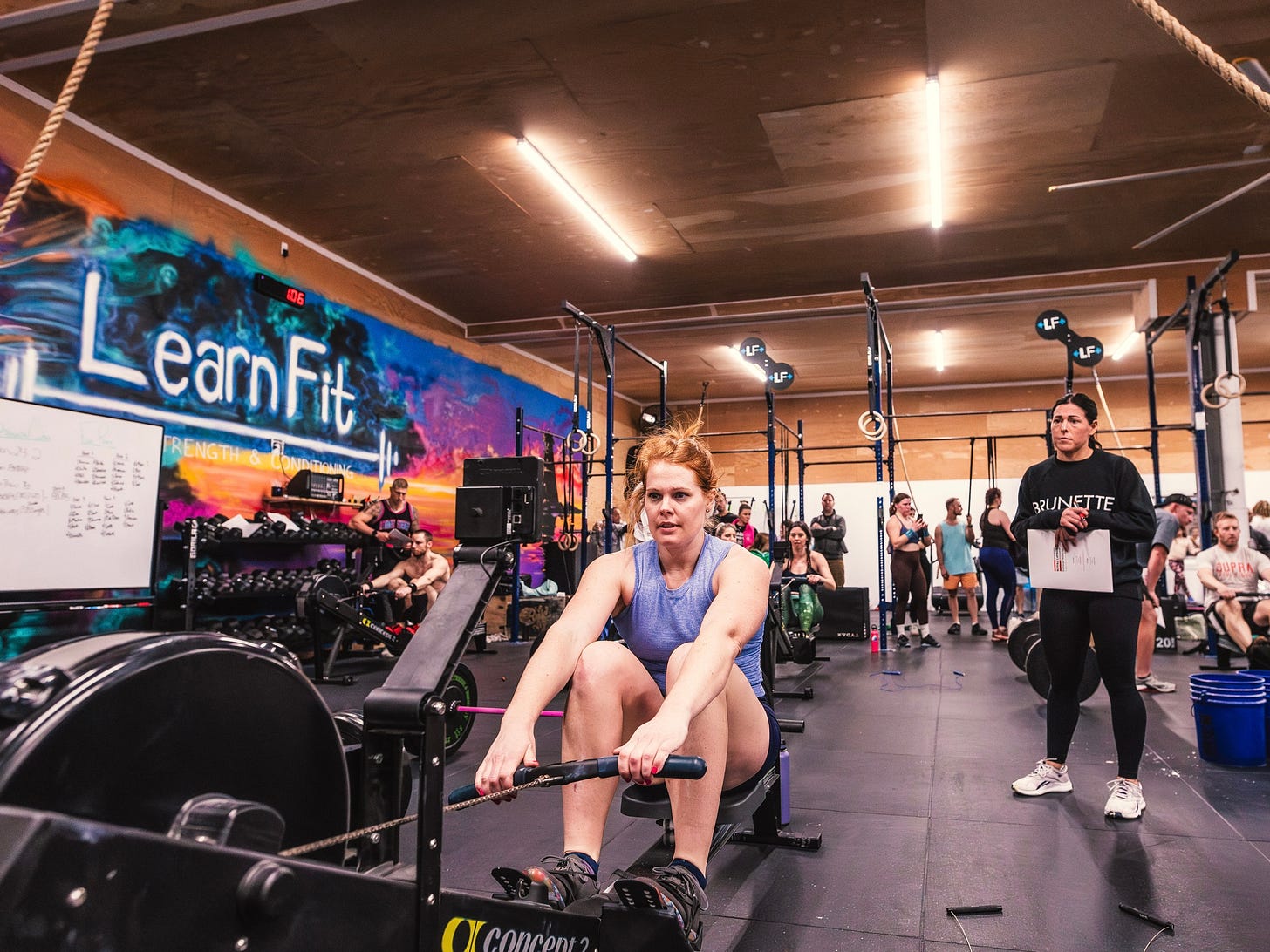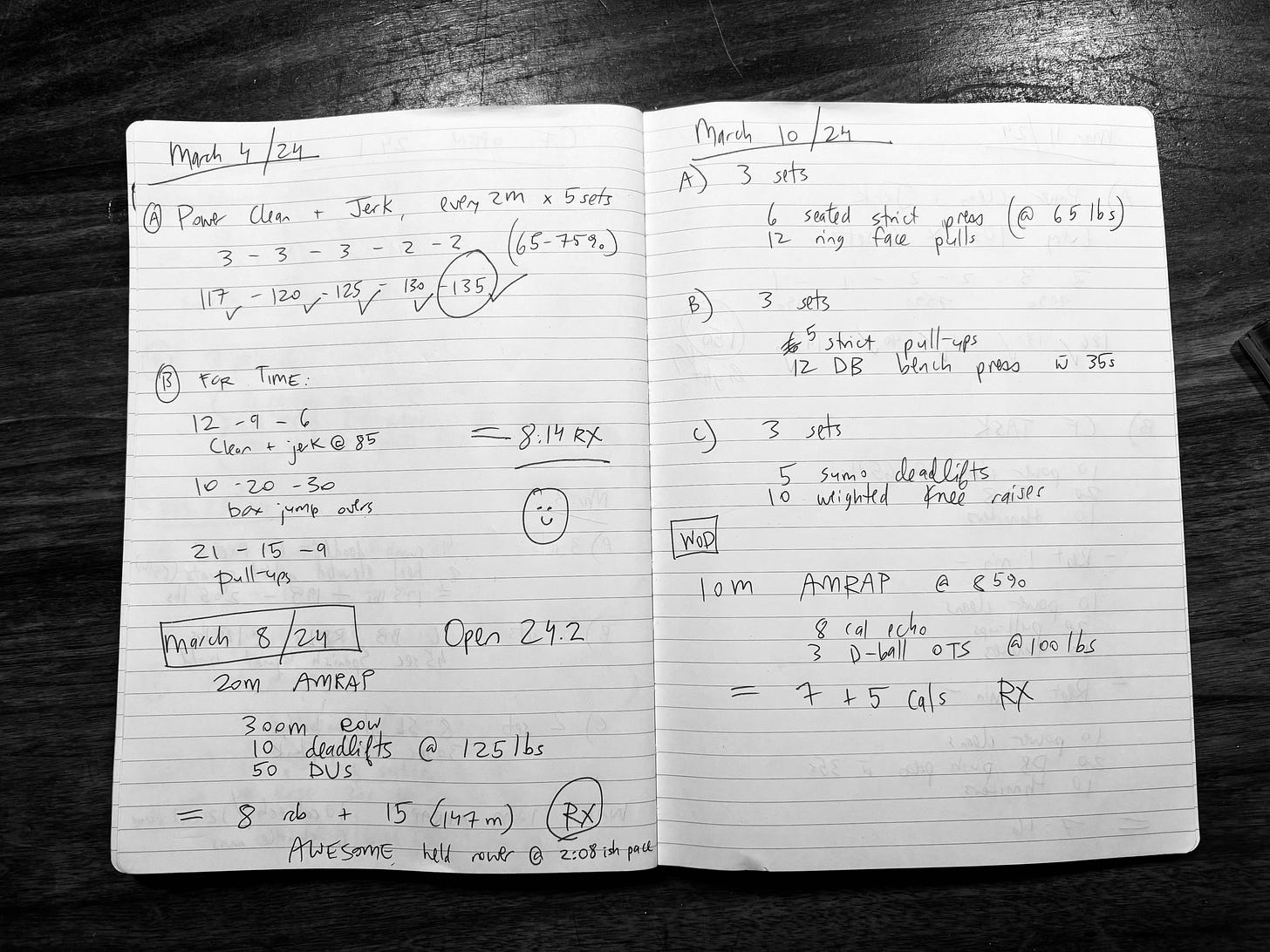The Paper Workout Journal
These messy, battered, chalk-stained notebooks are physical proof of personal progress.
I started going to the gym nearly 12 years ago, after having my second child. I needed to find some form of physical activity that would get me out of the house and keep me engaged physically, mentally, and socially. After trying a few things, I ended up at CrossFit, and I continue to attend classes 4-5 times weekly.
Throughout the whole process, I have kept a paper journal that documents every workout. Lately, this analog method has attracted attention at the gym. Several new members have commented on me “scribbling away,” wondering what I’m doing. One person asked if I keep a paper record because I “don’t like screens.” (She’d seen my book for sale in the display case in the gym lobby.)
Recently, I read a great Substack piece by Audrey Watters called “The Case for a Paper Fitness Journal,” which made a lot of sense to me. It made me want to share my own thoughts and experiences with this method that may seem old-fashioned, but is still relevant, in my opinion.
The Value of a Paper Trail
Most CrossFit gyms, including mine, have apps that post the day’s workout and a place to log a score. I use this app as well, first to see what the workout will be and then to enter my results. It’s useful to see everyone else’s scores, too; my sense is that it fuels healthy, friendly competition in the gym. (Entering scores is not mandatory, and not everyone does it.) Sometimes I use these scores as a reference to see what comparable athletes are doing, in order to gauge what I should aim for on a given day.
When you’ve been in the game as long as I have, you learn that apps don’t last forever. I’ve changed gyms three times over the past 12 years, and each time my online data has been lost. That is why I don’t rely on it entirely; plus, it doesn’t show the whole picture. Often, there are things I want to add that feel too private for the app (like how I felt physically or emotionally that day) or too detailed (like a specific positioning prompt I want to remember for next time).
Paper Is Fun—and Practical
So, I use this as an excuse to buy beautiful Moleskine, Leuchtturm, and MUJI notebooks and coloured pens, and I stash them in my gym bag. Each day before class, I open the app and copy the workout into my notebook. I do any necessary calculations, which is the basis of weightlifting training. I lift based on percentages of a “1 rep max” (1RM), which has been established prior, and often these percentages increase over the course of a training session.
For example, last week, I did 6 sets of power clean and jerks. Each set had decreasing reps (3-3-2-2-1-1) at increasing percentages (60-80%). I calculated and wrote out those specific weights in advance, so I could spend more time warming up and preparing mentally.
Usually, each week builds on the previous week’s numbers, so having a notebook makes it easy to flip back and see what I did a few days prior. Sometimes I just make a point of lifting 5-10 pounds more than the last time I did the same set.
These notebooks are useful for going back in time and seeing my progress over a few weeks, a year, five years, even a decade. I can compare my performance on specific workouts, such as the notorious “DT” that took me 8’45” in May 2022, but 9’14” in December 2021, which means I improved by a huge 29 seconds in just five months. (Maybe I just got more sleep the night before or ate a bigger breakfast; the app won’t tell me, but my notebook might.)
I add personal notes like, “That was awful” or “Felt amazing!” or “Sooo hot today” or “Feeling sluggish after two weeks off.” I have highlighted small victories, like, “First strict pull-up!” and “OMG MUSCLE-UP FINALLY!!!!!!!!” There could be a dozen happy faces and hearts around a big lift PR (personal record) that I’ve been hoping to get for a long time, like hitting a 140-pound squat snatch last summer or the 230-pound back squat I did last week (with “could’ve done more yay” scribbled beside it). My writing is not neat; often the pages are stained with sweat. But it doesn’t matter.
Perhaps the best part of the notebooks is seeing handwritten messages and doodles from my kids, particularly my youngest. I come across pictures of dinosaurs and “I love Mommy” on occasion.
Paper Is Real

A paper journal is distinctly physical and real, and I love handling it for that reason. I suspect that same reason is at the root of why I love going to the gym. After sitting in front of my computer all day, I crave a chance to move my body, throw around heavy objects, exert myself, break a sweat, spike my heart rate.
When I train, I am doing what Winston Churchill once recommended, which was to find hobbies that “use other parts of our minds and bodies to relieve the areas where we are overworked.” These sessions remind me of the body I am fortunate to inhabit for just a handful of decades on Earth—something that’s easy to forget when I’m lost in my head.
Paper is also more real to kids, who observe us parents at our hobbies. When they see us writing down a score or making calculations on paper, they understand what we are doing. This provides context for our actions in a way that logging an online score does not.
Smartphones are impressive for condensing numerous tools into a single source, but sometimes there is value in seeking out analog alternatives to some of these digital tools. Doing tasks visibly helps us to differentiate between them, and it helps our children to understand more about how adults operate in the world, instead of everything melding into one confusing category of “oh, they’re on their phone again.”
Paper Promotes Focus
By handling real paper and pens in between my lifting sets, I am able to maintain my focus. I can avoid looking at my muted phone for the entire hour that I’m at the gym, which means no Apple News notifications, no missed calls, no text messages that I might be tempted to respond to during the two-minute countdown between sets, which would then prevent me from preparing mentally for the next lift. This makes a huge difference, I’ve discovered. (For the same reason, I don’t like making small talk in between sets; I’m already thinking about and rehearsing the next lift.)
My collection of beat-up, dog-eared, chalk-covered notebooks are nobody’s treasure but my own, and they mean a lot to me. They’re a paper trail of the work I’ve put in over all these years and they delight me in a way that no app every could.
You Might Also Like:
On Supercharged Socializing
Move With Purpose
On Reclaiming Leisure
I recently set up pledges for The Analog Family. If you enjoy my work, please consider making a financial pledge. This newsletter is a labour of love thus far, but it takes a lot of time and energy! Pledges are a wonderful motivator for this work that I consider to be more important than ever.
You can also show support by buying my book and leaving an Amazon review!





Yes! There's something about a paper workout journal! I have a notebook from a few years ago where I simply took a page and drew in 100 boxes. For each mile I walked, I got to shade in a box. That was such a motivation! I'd be walking at the Y and want to stop at 1.5 miles but the idea of shading in two boxes instead of one appealed to me, so I'd keep going until I'd completed two miles. That was the most consistent I had been in working out regularly and quite the celebration when I'd walked 100 miles! Your post is a reminder for me to use a paper journal again!
As soon as I saw your notebook page I could tell you were a crossfitter 😄 This inspires me to get back to the gym notebook habit I used to have. Congrats on completing the open!